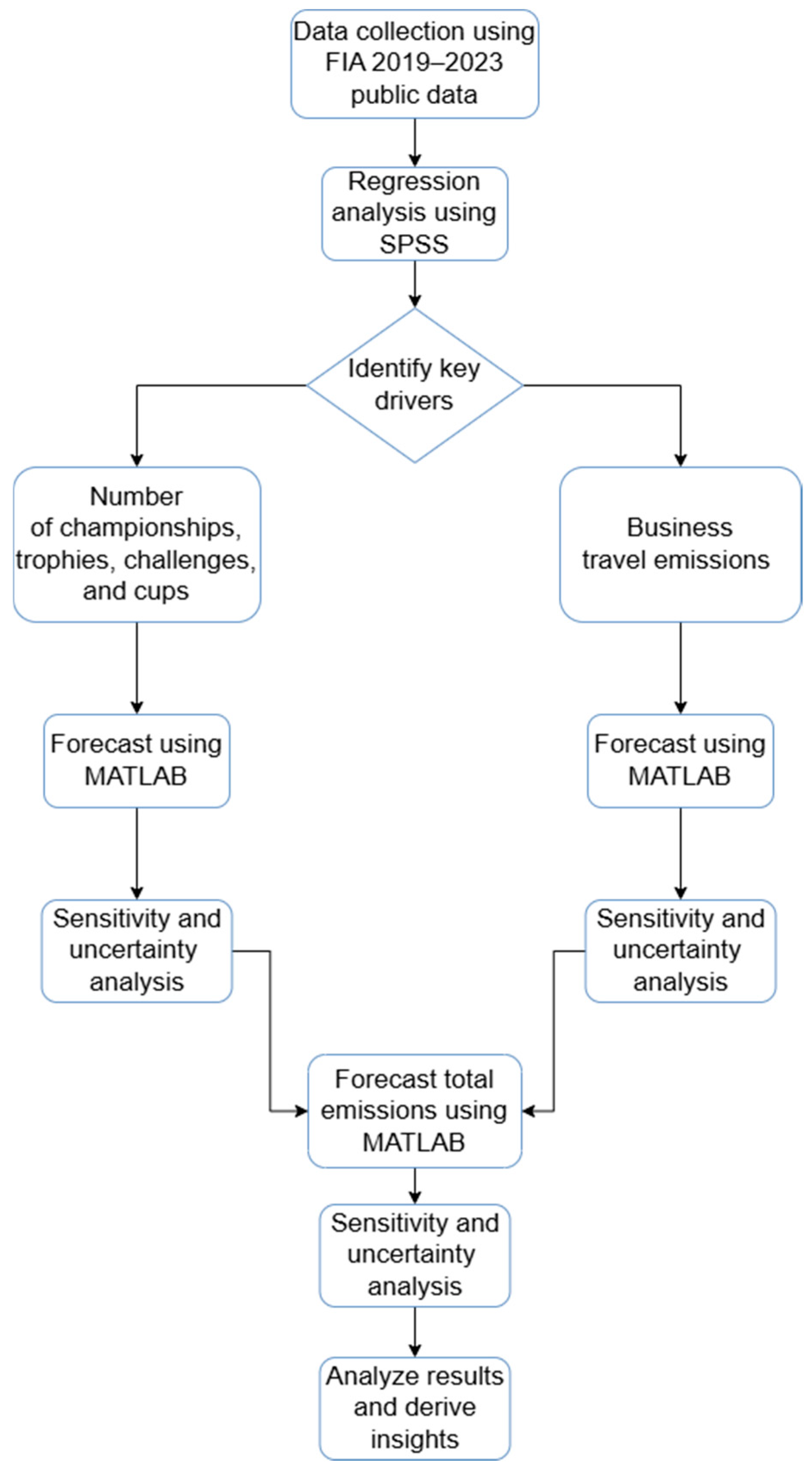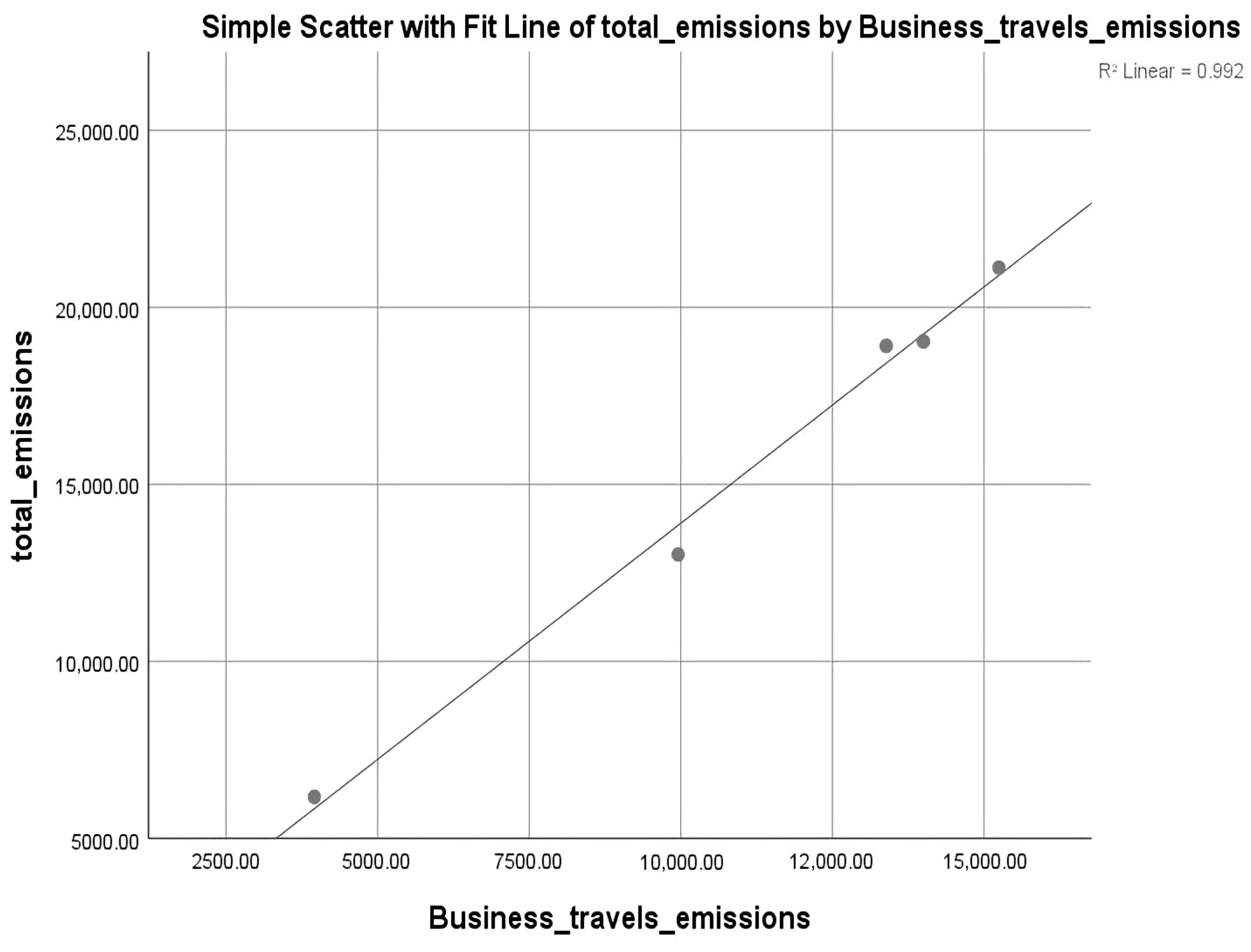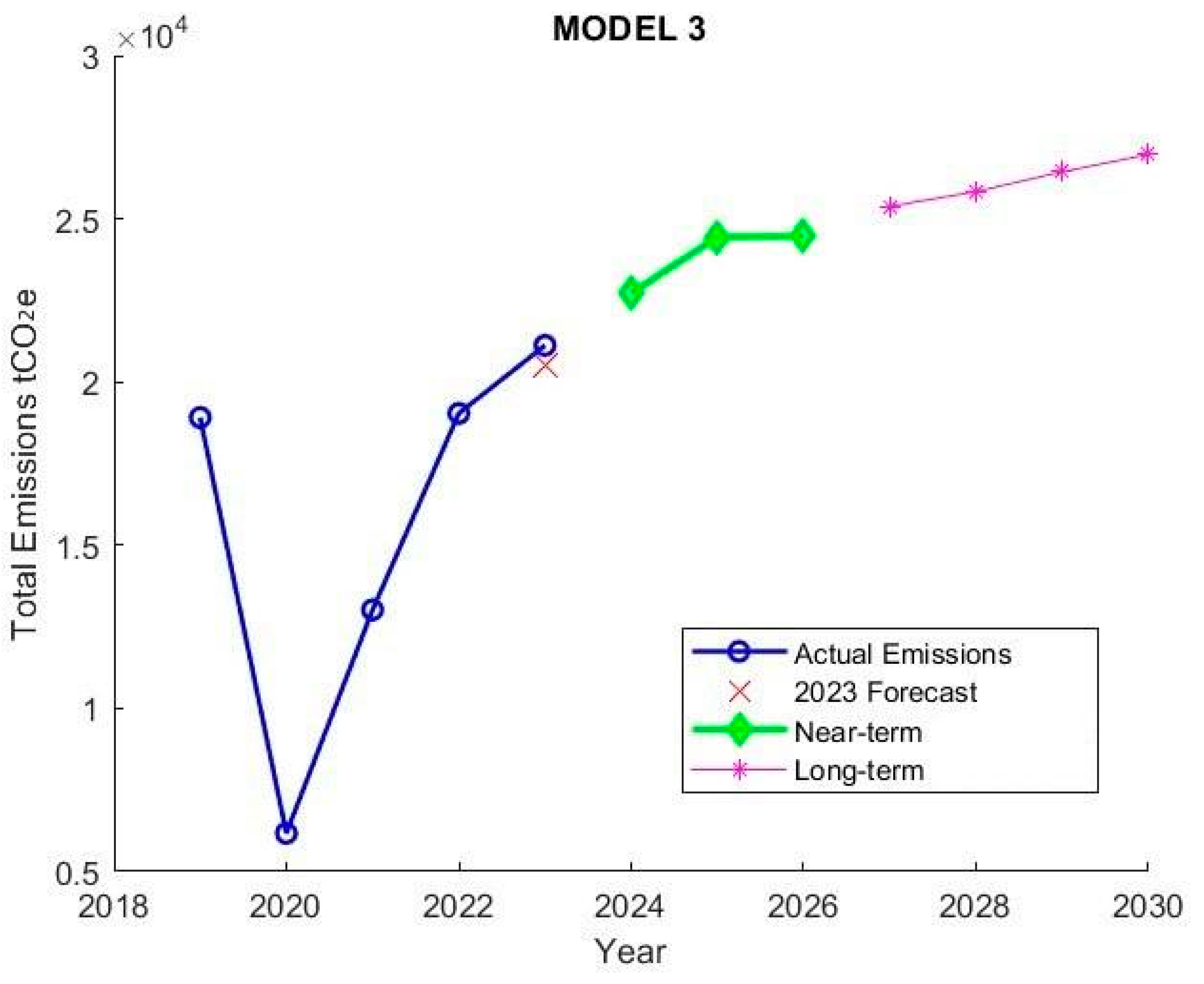Projecting the FIA’s GHG Emissions: A Forecast for the 2030 Sustainability Target
Abstract
1. Introduction
1.1. Problem Statement
1.2. Objective and Approach of the Study
1.3. Research Questions
- To what extent can the FIA’s self-reported key emission sources be statistically validated as the primary drivers of its total carbon footprint?
- What is the empirically projected trajectory of the FIA’s emissions to 2030, based on a model built from these validated drivers?
- How large is the implementation gap between this projected trajectory and the FIA’s official 2030 reduction target?
1.4. Contribution and Justification
- Methodological Novelty: It moves beyond descriptive reporting by developing a replicable, three-stage forecasting framework that integrates SPSS-based driver identification with deterministic MATLAB modeling, specifically designed for data-scarce environments common in early-stage sustainability reporting.
- Empirical Validation: It provides the first statistical evidence (R2 = 0.993) confirming that business travel and championship count are not just self-reported sources, but are in fact the statistically dominant drivers of the FIA’s emissions, and quantifies their marginal impact.
- Strategic Insight: It delivers the first peer-reviewed forecast of the FIA’s emissions trajectory, revealing a significant implementation gap—a projected 18% increase vs. a 50% reduction target—thereby providing a critical, evidence-based alert for strategic course-correction.
2. Literature Review
Critical Comparison and Identified Gap
3. Data and Methodology
3.1. Data
- Dependent variable:
- Total Emissions (metric tons CO2-equivalent), representing the FIA’s overall annual carbon footprint [21].
- Independent variables:
3.1.1. Key Assumptions and Justifications
- Data Completeness Assumption: It was assumed that the FIA’s publicly reported data is accurate, complete, and consistent with the GHG Protocol Corporate Standard, as stated in their reports. This assumption is fundamental to any analysis of secondary data and is considered reasonable for an organization of the FIA’s stature and under its reporting commitments.
- Handling of Missing Data: The 2022 Environmental Report did not explicitly report the Number of Events and the Number of championships, trophies, challenges, and cups. To address this gap without introducing bias, the missing values for 2022 were imputed using the average of the 2021 and 2023 values. This approach was selected because it minimizes the influence of short-term volatility (like the pandemic recovery) and provides a reasonable, conservative estimate based on the trend observed in the adjacent years.
- Temporal Scope Justification: Although the dataset spans only five years, this timeframe is analytically valuable as it captures distinct operational phases: a pre-pandemic baseline (2019), a pandemic-disrupted year (2020), and a post-pandemic recovery period (2021–2023). This scope is sufficient for initial trend detection and aligns with the early-phase monitoring needs of the FIA’s 2020–2030 strategy [6].
3.1.2. Addressing the Impact of the Pandemic Period
3.2. Statistical Analysis
3.3. Forecasting Models
3.3.1. Model 1: Predicting Number of Championships, Trophies, Challenges, and Cups
3.3.2. Model 2: Predicting Business Travel Emissions
3.3.3. Model 3: Predicting Total Emissions
3.3.4. Validation and Uncertainty Quantification
- Model 1 tested the impact of perturbing the anomalous 2020 data and varying the long-term growth rate, confirming the model’s resilience to outliers and parameter uncertainty.
- Model 2 evaluated the effect of shocks to championship counts and adjustments to the growth blending ratio, demonstrating stable and logical behavioral dynamics.
- Model 3 employed One-At-A-Time (OAT) perturbation of the composite growth rate, showing smooth and proportional output changes with no signs of structural instability.
4. Results
4.1. Regression Results
4.2. Forecast Results
4.2.1. Model 1 Forecast
4.2.2. Model 2 Forecast
4.2.3. Model 3 Forecast
4.3. Sensitivity Analysis
4.3.1. Model 1 Results
- Multi-Delta Analysis (2020 Perturbation): Artificial adjustments of ±5%, ±10%, and ±20% were applied to the 2020 data point to simulate noise or reporting inconsistencies. Across all future forecast years (2024–2030), these shocks produced no measurable impact on projected championship counts. The average, maximum, and minimum differences in forecasts remained at zero, confirming the model’s inherent resilience to outliers via its rolling-window smoothing mechanism.
- Growth Rate Sensitivity (2024–2030): The model’s reliance on a filtered median growth rate was tested by varying it ±10% from the baseline. A 10% reduction in the growth rate led to a cumulative under projection of −2.5% by 2030 (310 vs. baseline 318), whereas a 10% increase elevated the forecast to 326 (+2.5%). While early forecast years exhibited only ±0.8% divergence (2024), this widened to ±2.5% by 2030.
4.3.2. Model 2 Results
- Championship Impact with Temporal Decay: A ±20 unit perturbation in championship counts was introduced to assess the impact on emissions forecasts. The influence was most pronounced in the immediate forecast year but decayed exponentially over time, reaching approximately 30% of its original strength by 2030. This decay rate (≈2% annually) aligns with documented half-life effects observed in event-related economic shocks. The model’s decay logic ensures that it remains responsive to near-term volatility while preventing long-term overreliance on transient anomalies.
- Growth Rate Blending Sensitivity: Adjustments to the blend ratio between recent and historical growth revealed a trade-off between recency sensitivity and long-term stability. Under high recent growth (20%), the model activated a 15% growth cap when the blend ratio exceeded 0.6—consistent with econometric safeguards against over-extrapolation. Conversely, the model handled low-growth scenarios without requiring artificial constraints. The default ratio of 0.7 offered a balanced configuration, shown to optimize predictive accuracy by integrating recent volatility with structural trends.
4.3.3. Model 3 Results
- Decay Rate Sensitivity (Sustainability Scenarios): The model tested three decay scenarios—0.9 (strong sustainability), 1.0 (baseline), and 1.1 (weak sustainability)—applied to the composite growth structure. Results revealed that stronger sustainability assumptions produced more tempered emissions growth, whereas weaker assumptions led to modestly elevated projections. Importantly, the baseline scenario already incorporated sustainability-aware adjustments through tapered business travel growth rates, making the decay rate analysis an exploration of second-order effects.
- One-At-A-Time (OAT) Growth Rate Perturbation: Small perturbations (±5%) were applied to the annual growth rate while holding all other model components constant. This classical sensitivity method, appropriate for deterministic models with limited drivers, demonstrated smooth and proportional changes in output with no erratic behaviors or structural instabilities. These results validate the model’s internal coherence and its capacity to absorb minor forecasting errors or changes in planning assumptions.
4.4. Uncertainty Analysis
4.4.1. Model 1 Results
4.4.2. Model 2 Results
4.4.3. Model 3 Results
5. Discussion
5.1. Key Contributors to FIA’s Total Emissions
5.2. Emission Trajectories to 2030
5.3. Realism of FIA’s Sustainability Targets
5.4. The Value of Early Forecasting in Climate Governance
5.5. Strategic Recommendations for Faster Decarbonization
5.5.1. Incorporate AI-Driven Freight and Travel Optimization
5.5.2. Enhance Real-Time Emissions Monitoring and Transparency
5.5.3. Responsible Event Planning
5.6. Policy and Practical Implications
5.7. Limitations and Future Research
6. Conclusions
Author Contributions
Funding
Institutional Review Board Statement
Informed Consent Statement
Data Availability Statement
Conflicts of Interest
References
- Dolf, M.; Teehan, P. Reducing the carbon footprint of spectator and team travel at the University of British Columbia’s varsity sports events. Sport Manag. Rev. 2015, 18, 244–255. [Google Scholar] [CrossRef]
- Wilby, R.L.; Orr, M.; Depledge, D.; Giulianotti, R.; Havenith, G.; Kenyon, J.A.; Matthews, T.K.R.; Mears, S.A.; Mullan, D.J.; Taylor, L. The impacts of sport emissions on climate: Measurement, mitigation, and making a difference. Ann. N. Y. Acad. Sci. 2023, 1519, 20–33. [Google Scholar] [CrossRef]
- Zanella, M.; Ashraf, N.; Mahmood, Z. Carbon accounting for sustainability management: Case study of MICE events. J. Account. Organ. Change 2025, 21, 1–15. [Google Scholar] [CrossRef]
- Sturm, D.; Andrews, D.L.; Miller, T.; Bustad, J. Green light or black flag? Greenwashing environmental sustainability in Formula One and Formula E. Ann. Leis. Res. 2025, 28, 116–135. [Google Scholar] [CrossRef]
- Öztopcu, A. Environmental sustainability in sport: Formula 1’s SDGs responsiveness. Environ. Dev. Sustain. 2024, 26, 31075–31097. [Google Scholar] [CrossRef]
- Fédération Internationale de l’Automobile. FIA Environmental Strategy 2020–2030: Summary. Available online: https://www.fia.com/action-environment (accessed on 9 February 2025).
- Fédération Internationale de l’Automobile (FIA). FIA Environmental Report 2023: Based on Results Achieved in 2022; FIA: Geneva, Switzerland, 2023. [Google Scholar]
- Fédération Internationale de l’Automobile (FIA). FIA Environmental Accreditation Programme Guidelines (Version 1); FIA: Geneva, Switzerland, 2020. [Google Scholar]
- Chen, W.; Wu, X. Evaluating Effectiveness of Low-Carbon Transition Policy Mix Based on Urban Private Car Trajectory Data. Sci. Program. 2022, 2022, 4702095. [Google Scholar] [CrossRef]
- Ferrer, A.L.C.; Thomé, A.M.T. Carbon Emissions in Transportation: A Synthesis Framework. Sustainability 2023, 15, 8475. [Google Scholar] [CrossRef]
- Xu, X.; Du, H.; Lian, Z. Discussion on Regression Analysis with Small Determination Coefficient in Human-Environment Researches. Indoor Air 2022, 32, e13117. [Google Scholar] [CrossRef]
- Jing, Q.-L.; Liu, H.-Z.; Yu, W.-Q.; He, X. The Impact of Public Transportation on Carbon Emissions—From the Perspective of Energy Consumption. Sustainability 2022, 14, 6248. [Google Scholar] [CrossRef]
- Guo, L.; Chen, B.; Zhang, H.; Xu, G.; Lu, L.; Lin, X.; Kong, Y.; Wang, F.; Li, Y. Improving PM2.5 Forecasting and Emission Estimation Based on the Bayesian Optimization Method and the Coupled FLEXPART-WRF Model. Atmosphere 2018, 9, 428. [Google Scholar] [CrossRef]
- Cui, X.; Zhao, K.; Zhou, Z.; Huang, P. Examining the uncertainty of carbon emission changes: A systematic approach based on peak simulation and resilience assessment. Environ. Impact Assess. Rev. 2021, 91, 106667. [Google Scholar] [CrossRef]
- Kafle, S.C. Correlation and Regression Analysis Using SPSS. OCEM J. Manag. Technol. Soc. Sci. 2019, 1, 125–132. [Google Scholar]
- Esakki, N. Environmental Economics and Statistical Modeling: An SPSS-Based Approach. Trends Financ. Econ. 2025, 3, 63–75. [Google Scholar]
- Holzbecher, E. Environmental Modeling: Using MATLAB®, 2nd ed.; Springer: Berlin, Germany, 2012; pp. 1–450. [Google Scholar] [CrossRef]
- Tang, J.; Yang, Y.; Li, L.; Dong, K.; Yu, W.; Yang, X.; Zhang, X. Scenario analysis of transportation carbon emissions in China based on machine learning and deep neural network models. Environ. Res. Lett. 2023, 18, 064018. [Google Scholar] [CrossRef]
- Alhindawi, R.; Abu Nahleh, Y.; Kumar, A.; Shiwakoti, N. Projection of Greenhouse Gas Emissions for the Road Transport Sector Based on Multivariate Regression and the Double Exponential Smoothing Model. Sustainability 2020, 12, 9152. [Google Scholar] [CrossRef]
- Javanmard, M.E.; Tang, Y.; Wang, Z.; Tontiwachwuthikul, P. Forecast energy demand, CO2 emissions and energy resource impacts for the transportation sector. Appl. Energy 2023, 338, 120830. [Google Scholar] [CrossRef]
- Fédération Internationale de l’Automobile. Appendix 1—FIA Sustainability Report. Available online: https://sustainabilityreport.fia.com/appendices/appendix-1/ (accessed on 9 February 2025).
- Fédération Internationale de l’Automobile. Appendix 2—FIA Sustainability Report. Available online: https://sustainabilityreport.fia.com/appendices/appendix-2/ (accessed on 9 February 2025).
- Fédération Internationale de l’Automobile. FIA Activity Reports. Available online: https://www.fia.com/fia-activity-reports (accessed on 9 February 2025).
- IBM Corp. IBM SPSS Statistics for Windows, Version 25.0; IBM Corp: Armonk, NY, USA, 2022. [Google Scholar]
- Field, A. Discovering Statistics Using IBM SPSS Statistics, 4th ed.; SAGE Publications: Thousand Oaks, CA, USA, 2013. [Google Scholar]
- Shrestha, N. Detecting Multicollinearity in Regression Analysis. Am. J. Appl. Math. Stat. 2020, 8, 39–42. [Google Scholar] [CrossRef]
- Stataiml. Thresholds for Detecting Multicollinearity. Available online: https://stataiml.com/posts/60_multicollinearity_threshold_ml/ (accessed on 5 July 2024).
- MathWorks. MATLAB R2024b. 2024. Available online: https://www.mathworks.com/products/new_products/latest_features.html (accessed on 9 February 2025).
- Kumari, S.; Singh, S.K. Machine learning-based time series models for effective CO2 emission prediction in India. Environ. Sci. Pollut. Res. 2023, 30, 116601–116616. [Google Scholar] [CrossRef]
- Rahaman, S.U.; Abdul, M.J. Quantifying uncertainty in economics policy predictions: A Bayesian & Monte Carlo based data-driven approach. Int. Rev. Financ. Anal. 2025, 102, 104157. [Google Scholar] [CrossRef]
- Akter, J. Bootstrapped Durbin-Watson Test of Autocorrelation for Small Samples. ABC J. Adv. Res. 2014, 3, 68–72. [Google Scholar] [CrossRef]
- Grace-Martin, K.; Interpreting the Intercept in a Regression Model. The Analysys Factor. Available online: https://www.theanalysisfactor.com/interpreting-the-intercept-in-a-regression-model/ (accessed on 21 December 2022).
- Cooper, J.A.; McCullough, B.P. Bracketing sustainability: Carbon footprinting March Madness to rethink sustainable tourism approaches and measurements. J. Clean. Prod. 2021, 318, 128475. [Google Scholar] [CrossRef]
- Osner, O. F1 and Sustainability—How can a Motorsport Exist in a Climate-Friendly World? Sports Analytics Group Berkeley. Available online: https://sportsanalytics.studentorg.berkeley.edu/articles/f1-sustainability.html (accessed on 17 May 2024).
- Mathison, C.; Burke, E.J.; Munday, G.; Jones, C.D.; Smith, C.J.; Steinert, N.J.; Wiltshire, A.J.; Huntingford, C.; Kovacs, E.; Gohar, L.K.; et al. A rapid-application emissions-to-impacts tool for scenario assessment: Probabilistic Regional Impacts from Model patterns and Emissions (PRIME). Geosci. Model Dev. 2025, 18, 1785–1808. [Google Scholar] [CrossRef]
- Lye, Y.X.; Chew, Y.E.; Foo, D.C.Y.; How, B.S.; Andiappan, V. Carbon emission reduction strategy planning and scheduling for transitioning process plants towards net-zero emissions. RSC Sustain. 2024, 3, 929–945. [Google Scholar] [CrossRef]
- Rottoli, M.; Dirnaichner, A.; Kyle, P.; Baumstark, L.; Pietzcker, R.; Luderer, G. Coupling a Detailed Transport Model to the Integrated Assessment Model REMIND. Environ. Model. Assess. 2021, 26, 891–909. [Google Scholar] [CrossRef]
- Speizer, S.; Fuhrman, J.; Lopez, L.A.; George, M.; Kyle, P.; Monteith, S.; McJeon, H. Integrated assessment modeling of a zero-emissions global transportation sector. Nat. Commun. 2024, 15, 4439. [Google Scholar] [CrossRef] [PubMed]
- Fédération Internationale de l’Automobile (FIA). FIA sustainability and D&I Report 2023; FIA: Geneva, Switzerland, 2023. [Google Scholar]
- Bryce, K.; Hunter, K.L. Enhancing climate change planning and adaptive management in marine protected areas through targets, thresholds, and social-ecological objectives. Front. Mar. Sci. 2024, 11, 1339871. [Google Scholar] [CrossRef]
- Martin, G.M.; Frazier, D.T.; Loaiza-Maya, R.; Huber, F.; Koop, G.; Maheu, J.; Nibbering, D.; Panagiotelis, A. Bayesian Forecasting in the 21st Century: A Modern Review (Working Paper No. 01/23); Monash University, Department of Econometrics and Business Statistics: Melbourne, Australia, 2023. [Google Scholar]
- Chen, W.; Men, Y.; Fuster, N.; Osorio, C.; Juan, A.A. Artificial Intelligence in Logistics Optimization with Sustainable Criteria: A Review. Sustainability 2024, 16, 9145. [Google Scholar] [CrossRef]
- Wulandari, R.S.; Cahyadi, T.; Winarno, W.; Harianto, B.B. Exploring a decade of maritime transportation studies: Trends and developments. Int. J. Innov. Res. Sci. Stud. 2025, 8, 3807–3819. [Google Scholar] [CrossRef]
- Xuan, S.; Zhou, Z.-K.; Zhou, J.-X.; Xia, Q.-F.; Qin, Y.-N.; Wu, J.-P. The Impact of Sporting Events on Carbon Emissions and the Emission Reduction Measures: A Systematic Review from 2019 to 2024. Pol. J. Environ. Stud. 2025, 34, 1–15. [Google Scholar] [CrossRef]







| Predictor | B | SE | t | p |
|---|---|---|---|---|
| (Intercept) | 564.45 | 806.88 | 0.70 | 0.535 |
| Business Travel Emissions | 1.334 | 0.067 | 19.88 | <0.001 |
| Predictor | B | SE | t | p |
|---|---|---|---|---|
| (Intercept) | 254.45 | 1613.80 | 0.16 | 0.889 |
| Number of Championships, Tro-phies, Challenges, and Cups | 3.03 | 12.59 | 0.24 | 0.832 |
| Business Travel Emissions | 1.30 | 0.17 | 7.82 | 0.016 |
Disclaimer/Publisher’s Note: The statements, opinions and data contained in all publications are solely those of the individual author(s) and contributor(s) and not of MDPI and/or the editor(s). MDPI and/or the editor(s) disclaim responsibility for any injury to people or property resulting from any ideas, methods, instructions or products referred to in the content. |
© 2025 by the authors. Licensee MDPI, Basel, Switzerland. This article is an open access article distributed under the terms and conditions of the Creative Commons Attribution (CC BY) license (https://creativecommons.org/licenses/by/4.0/).
Share and Cite
Al-rubaye, A.; Naimi, S. Projecting the FIA’s GHG Emissions: A Forecast for the 2030 Sustainability Target. Sustainability 2025, 17, 10633. https://doi.org/10.3390/su172310633
Al-rubaye A, Naimi S. Projecting the FIA’s GHG Emissions: A Forecast for the 2030 Sustainability Target. Sustainability. 2025; 17(23):10633. https://doi.org/10.3390/su172310633
Chicago/Turabian StyleAl-rubaye, Aya, and Sepanta Naimi. 2025. "Projecting the FIA’s GHG Emissions: A Forecast for the 2030 Sustainability Target" Sustainability 17, no. 23: 10633. https://doi.org/10.3390/su172310633
APA StyleAl-rubaye, A., & Naimi, S. (2025). Projecting the FIA’s GHG Emissions: A Forecast for the 2030 Sustainability Target. Sustainability, 17(23), 10633. https://doi.org/10.3390/su172310633







